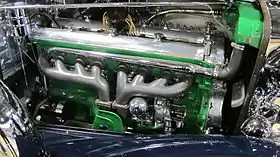Duesenberg Straight-8 engine
The Duesenberg Straight-8 engine was produced from 1921 to 1937 and sold in Duesenberg automobiles. Fred and August Duesenberg got their start building experimental racing engines which achieved a great deal of success. Among their accomplishments are wins at the Indianapolis 500, the 1921 French Grand Prix and speed records at the Bonneville Salt Flats. They used the expertise they had gained to start building production engines and cars which were renowned for their performance and luxury.
| Duesenberg Straight 8 | |
|---|---|
| Overview | |
| Manufacturer | Duesenberg/Lycoming |
| Production | 1921–1937 |
| Layout | |
| Configuration | Overhead cam Multivalve Overhead valve Straight-8 engine |
Among the novel design features (for a pre-1940 production engine) seen on various Duesenberg engines are single- and double-overhead camshafts, three- and four-valve heads, superchargers and aluminum castings.
Production engines
| Duesenberg Model J engine[1] | |
|---|---|
 | |
| Overview | |
| Manufacturer | Duesenberg |
| Production | 1928-1937 |
| Layout | |
| Configuration | Straight-eight engine |
| Displacement | 420 cu in (6,900 cc) |
| Cylinder bore | 3.74 in (95 mm) |
| Piston stroke | 4.76 in (121 mm) |
| Cylinder block material | cast iron |
| Cylinder head material | cast iron |
| Valvetrain | DOHC, 4 valves per cylinder |
| Compression ratio | 5.7:1 |
| Combustion | |
| Supercharger | Duesenberg centrifugal (optional from 1932) |
| Fuel system | Single updraft Schleber carburetor |
| Fuel type | gasoline |
| Cooling system | water-cooled |
| Output | |
| Power output |
|
| Chronology | |
| Predecessor | Duesenberg Model A engine |
| Production | Engine | Displacement | Bore x stroke | Cam and valve | Model |
|---|---|---|---|---|---|
| 1921-27 | 260 | 259.7 cu in (4,256 cc)[2] | 2.8750" X 5.0000" (72.16 x 125.50 mm) | SOHC 2v | A,X |
| 1928-37 | 420 | 419.7 cu in (6,878 cc) | 3.7500" X 4.7500" (94.12 x 119.23 mm) | DOHC 4v | J,SJ,SSJ |
Competition engines
The engines listed below were designed by Duesenberg for the Indianapolis 500. Some engines of the 122 CID and 91 CID design were bored/stroked to larger displacements for other races classes, after the 1930 rules change at Indianapolis.
| Production | Engine | Displacement | Bore x stroke | Cam and valve |
|---|---|---|---|---|
| 1919-21[3] | 300 | 296.9 cu in (4,865 cc) | 3.0000" X 4.7500" (75.30 x 131.78 mm) | SOHC 3v |
| 1921-23[3] | 183 | 183.0 cu in (2,999 cc) | 2.5000" X 4.6600" (62.75 x 116.97 mm) | SOHC 3v |
| 1923-25[3] | 122 | 121.3 cu in (1,988 cc) | 2.3750" X 3.4220" (59.61 x 85.89 mm) | DOHC 4v / DOHC 2v (supercharged)[4] |
| 1926-29[3] | 91 | 90.3 cu in (1,480 cc) | 2.2860" X 2.7500" (57.38 x 69.03 mm) | DOHC 4v |
| 1930-32[5] | 244 | 244 cu in (4,000 cc) | unk | SOHC desmodromic |
Notes
- Cheetham, Craig (2006) [2004]. Vintage Cars. St. Paul, MN USA: Motorbooks. pp. 75, 79. ISBN 978-0-7603-2572-8. Retrieved 2013-12-13.
- "Directory Index: Duesenberg/1922_Duesenberg_Model_A_Catalogue". Oldcarbrochures.com. Retrieved 2011-11-20.
- Borgeson, Griffith (1998). The golden age of the American ... - Google Books. ISBN 978-0-7680-0023-8. Retrieved 2009-07-05.
- "1925 Duesenberg Eight Speedway Roadster". Retrieved 27 August 2016.
- "Duesenburg SOHC 8 Cylinder Indianapolis Racing Engine". Retrieved 27 August 2016.
References
- Griffith Borgeson (1997). The Golden Age of the American Racing Car. SAE International. ISBN 978-0-7680-0023-8.